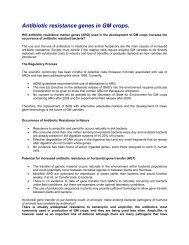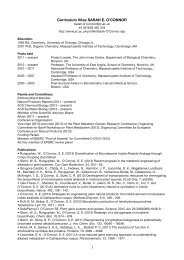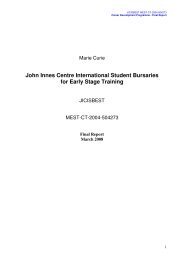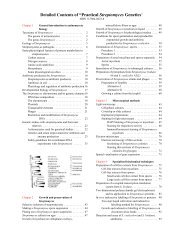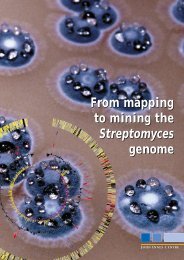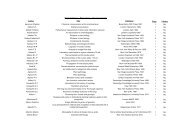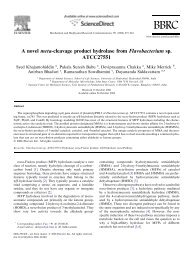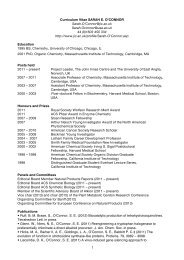Economic Impact brochure - John Innes Centre
Economic Impact brochure - John Innes Centre
Economic Impact brochure - John Innes Centre
Create successful ePaper yourself
Turn your PDF publications into a flip-book with our unique Google optimized e-Paper software.
Wheat research in the pipeline<br />
Wheat breeding<br />
The success of wheat is partly due to its high fertility,<br />
a product of the stability of its genome. This stability is<br />
however also a barrier to introducing new traits.<br />
JIC scientists have characterised a stretch of DNA<br />
responsible for the stability of the wheat genome, called<br />
the Ph1 locus. Ph1 is the major barrier to exchanging<br />
genetic material between the chromosomes of wheat<br />
and wild species. The scientists are now investigating<br />
the possibility of temporarily switching off the Ph1<br />
locus to allow breeders to cross breed wheat with its<br />
wild relatives.<br />
This has the potential to revolutionise wheat<br />
breeding worldwide. It would open up a large pool<br />
of desirable traits to commercial cultivars such as<br />
salt tolerance, drought resistance, pest and disease<br />
resistance and increased yield. These valuable traits are<br />
otherwise unavailable.<br />
Yield<br />
Yield is a complex trait influenced by many<br />
environmental and genetic factors. It was thought that<br />
the genetic component determining yield was made up<br />
of many different genes each exerting a small influence,<br />
but recent work led by the <strong>John</strong> <strong>Innes</strong> <strong>Centre</strong> has<br />
challenged this view.<br />
Several stretches of the genome, known as quantitative<br />
trail loci (QTLs) have been identified that exert large<br />
effects on yield, in different environments. The<br />
molecular mechanisms underlying the genes are not<br />
well understood. JIC scientists are leading the effort to<br />
find the precise genetic basis for their effect on yield.<br />
As part of this effort they are collaborating with the<br />
National Institute of Agricultural Botany (NIAB) on precompetitive<br />
research to improve the genetic resources<br />
available to wheat breeders. JIC scientists are also<br />
leading work to determine the complete genetic<br />
make-up of bread wheat. This will be led by innovative<br />
applications of next generation DNA sequencing.<br />
Wheat research has a profound social and economic<br />
impact because wheat feeds 40% of the world’s<br />
population providing about 20% of the calories<br />
eaten globally.<br />
!<br />
Nitrogen fixation<br />
Plants require nitrogen, and crops require additional<br />
nitrogen to be added in the form of fertilisers. Fertilisers<br />
can increase yield by as much as 50%, but their<br />
production uses more fossil fuels than any other<br />
agricultural process. They also cause pollution when<br />
they leach into groundwater and the atmosphere.<br />
N 2<br />
O created by producing and applying nitrogenous<br />
fertilisers is the most important greenhouse gas<br />
produced by agriculture.<br />
Some plants, such as peas, source their own nitrogen<br />
by taking it from the air. These plants house bacteria in<br />
nodules on their roots. The bacteria take nitrogen from<br />
the air and convert it into a form of fixed nitrogen that<br />
plants can use. The interaction between the plant and<br />
the bacteria involves a complex system of signals.<br />
JIC scientists are working to understand these<br />
interactions and to develop new strategies to transfer<br />
nitrogen fixation to other crops. If successful these<br />
will lead to a substantial reduction in the carbon footprint<br />
of world agriculture and to the improved sustainability of<br />
crop production. Increased yields could be achieved with<br />
lower inputs.<br />
ECONOMIC SNAPSHOT<br />
Nitrogen fertiliser production consumes 1.2% of<br />
the world’s total energy on an annual basis. Extending<br />
the capacity for fixing nitrogen to maize, rice and<br />
wheat, would dramatically reduce the production<br />
costs of world agriculture.<br />
Furthermore, by reducing the dependency of crops on<br />
an oil-guzzling and expensive process, it would also help<br />
reduce the impact of oil prices on the price of food.



